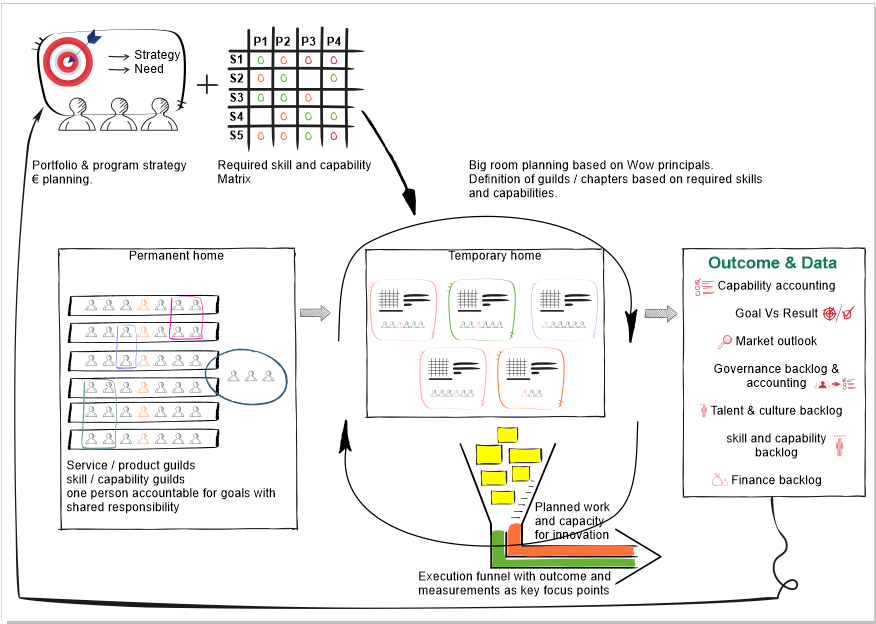KNOM Element Four, executing reliable pilot programs: Part 5


SAKET BIVALKAR
Business Coach
“Most leaders would agree that they’d be better off having an average strategy with superb execution than a superb strategy with poor execution.” – Stephen Covey
In part five of this article series chronicling the KNOM organisation, we will discuss how products, services or solutions are executed for high impact and data evaluation. In Element Three: Big Room Planning & Temporary Home, we covered how the KNOM organisation develops and designs new prototypes. Yet, to execute these prototypes efficiently and with high impact, they must go through an execution funnel and be packaged into usable or marketable pilot programs.
Analogously, the prototypes in Element Three are prepared ingredients not yet transformed into a presentable meal. This element four is the cook, taking these and packaging them into a finished meal. As such, the prototypes from Element Three are constituent parts of a finished, packaged product, service or solution.
The reason, as Stephen Covey eloquently expressed, is with high-performing executions, you can transform a mediocre strategy and prototypes into effective products, services or solutions.
So to adequately explain how the Execution Funnel functions, we must go through its four prerequisites.

First Prerequisite: Let’s talk about innovation
The products, services and solutions ending up at the end of the Execution Funnel can be customer-facing, i.e. marketable products or services, or internal improvements on processes and activities, like a more efficient financial system.
When we covered Element 3: Big Room Planning & Temporary Home, we discussed how intrinsic (product extension or improvements) and extrinsic (new products or solutions) innovations were developed and designed into prototypes. Yet, for the Execution Funnel, we have to peer through a more granular lens. The reason is each prototype in Temporary Home will generally follow three types of innovations: process, business model, and product/service.
- Process innovations are internal improvements that cut costs or are more efficient and effective once implemented. In other words, these innovation initiatives improve business activities. Note that in some cases, process innovations can be market-facing and act as infrastructure innovations. Such are transformative new ways industries function or generate value while being the most impactful. A known example of an infrastructure innovation is the internet.
- Business model innovations are new ways of delivering value to the customer. A recent disruptive business model that has gained traction is the platform business model, radically changing how organisations provide value and establish relationships with their customers.
- Product/Service innovations are customer-facing and are new ways of improving the service or product. This could be intrinsic in a product extension or improvement, or extrinsic with an entirely new product or service.
While there is a general idea in Big Room Planning & Temporary Home that the prototype worked on fits either of these three types, the Execution Funnel finalises the process, acting as the final stop before rollout. In other words, the Execution Funnel will transform one or combine multiple prototypes into packaged and marketable pilot programs.
Second Prerequisite: The Owner
The Execution Funnel in the KNOM must have an Owner from each temporary program carry over to the Execution Funnel. These Project Owners are responsible and accountable for executing what was developed and designed in Element Three in the Execution Funnel. Thus this prerequisite ensures a standardised quality and cross-departmental collaboration while upholding strategies formed in Element Two: Strategy Formation & Planning.
Third Prerequisite: Mitigate risks
Speaking of Element Two, the Owner must ensure that the final pilot program(s) follow the risk mitigators discussed in Element Two and Element Three. To brush up on them, these are five dimensions each finished pilot program must adhere to either mitigate potential risks or increase possible positives in financial, legal, technical, social, and operational dimensions.
Fourth Prerequisite: Continual improvement
The last crucial aspect of Element Four: Execution Funnel is to set up the next Element Five: Outcome & Data Insights. It does this by implementing marked-based analytics and KPIs to each pilot program connected to the established Strategy Formation in Element Two.
This means the final packaged product, service or solution will have built-in data aggregation like observation, retros, OKRs, and so on for organisational matters, and data methods for external data collection. Thus, making Element Five’s data extraction and insights gathering easier and streamlined.
Conveniently, this leads us to the final article of this series, covering the last Element Five: Outcome & Data Insights.
Realising your Strategy: The Critical Role of Operating Models
Organizations must continuously adapt and evolve to stay ahead of the competition. One key factor in achieving realisation of strategy is the operating model, which serves as the foundation for execution and provides a clear guide for how resources are organised to get critical work done.
Learning to Change: How Organizational Learning Fuels Transformation
From the importance of leadership support to leveraging technology for accessible learning, we cover the essential elements that make learning the heartbeat of organizational transformation.
Deciphering the Essence of an Operating Model
Explore the essence of operating models in business transformation. Uncover components, real-world insights, and the path to organizational brilliance. #BusinessTransformation #OperatingModels


